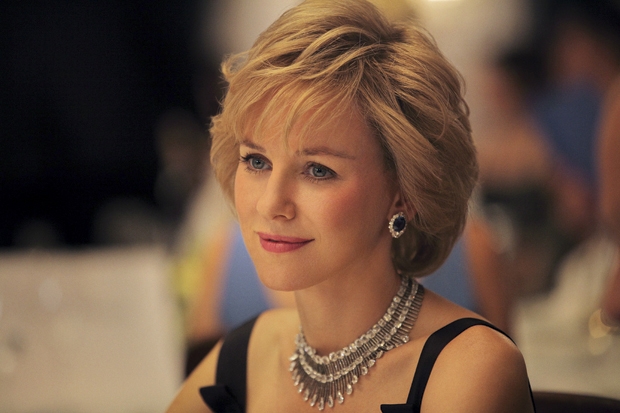Someone who knows their Dianaology will have to fill me in – did this actually happen? The late Princess Di is walking through central Portofino in Italy. She’s being jostled on all sides by an insistent public and an even more insistent swarm of photographers, when, suddenly, the crowds part. There, huddled by his family, is a thin blind man. She reaches out to him and he reaches back, taking her hands. Then he presses at her face as though it’s Braille; trying, as movie blind-people are wont to do, to read her soul. Sunlight streams down from the heavens.
We never see the man’s sight restored — perhaps that’s for the spin-off, Eyes Wide Open: The Diana Miracles — but we get the point. The Diana of Oliver Hirschbiegel’s Diana is the Messiah as shot by Mario Testino. We’re meant to sit there in wonder, but we just wonder how anyone ever thought this was a good idea.
Presumably, Naomi Watts once did, which is why she gamely wore a bouffant wig and a prosthetic nose to play the title role, although she might be regretting the effort now. This is a film so inept that, even with its messianic overtones, it cannot be counted as a hagiography. A hagiography idealises its subject, whereas Diana accidently denigrates its. A typical scene has Diana waking up a friend at 3:30 in the morning and wailing, ‘I’ll never be happy again!’ Except she is, the very next day, when she makes up with her Pakistani heart surgeon boyfriend Hasnat Khan. Forget the People’s Princess — this is one annoying drama queen.
That’s mostly what the film is about: the difficult course of her relationship with Khan in the last two years of her life. And, in the process of exploring this, it devolves into a series of clichés on the theme of heartache. Our heroine mopes around on her sofa, watching daytime teevee. She runs away from her lover with a cry of ‘Don’t follow me!’ and doesn’t stop as her shoes fall off. And although she’s spared from crying into a tub of strawberry cheesecake Häagen-Dazs, she does cry over her official correspondence. Rather than making the former Princess of Wales human, Diana makes her a platitude in pearls.
But far better that she’s doing her sub-Bridget Jones routine than trudging through this film’s love scenes. I still can’t work out what the proper reaction to them should be: boredom or crashing nausea. Lines such as ‘I love feeling your hand there’ and ‘you have power over death’ probably inspire a bit of both. In any case, they contaminate everything that’s around them. It’s hard to stay switched on for the obligatory landmine stuff, or for the few times when Diana grudgingly attempts to interrogate its subject.
Perhaps all this is how it truly was, but I wouldn’t take this movie’s word for it. There are various interviews with the director Hirschbiegel in which he strains to emphasise how journalistic Diana is, except he always comes a cropper against a single question: did Diana and Khan really make syrupy love in the back of a car, overlooking the white cliffs of Dover? Oh, ah, that scene is more a sense of what their relationship might have been like. Who knows what we’re to make of the film’s suggestion that Dodi Fayed was a rebound chump, holidaying with Di while she pined for her heart surgeon.
I’ll give Diana its due, though: there were about 30 seconds that I did enjoy. After yet another break-up with Khan, we see Princess Di, in quickfire montage, dancing in a neon nightclub, trying to intercede as a man and a woman argue in the gloom, and then shopping on Bond Street. And all that happens as an ominous, electric note growls in the background. We’ve suddenly, unintentionally, entered a David Lynch film. And with Watts in the lead, it’s rather like his Mulholland Drive (2001). Bring on the sinister cowboys and the overwrought lesbian sex scenes!
But 30 seconds is a poor return on a 113-minute movie. In fact, according to my accountants, it adds up to about four pence of a £10 ticket. They advise that, for the sake of your pocketbook, you watch Mulholland Drive itself. Or, if you really want to see a biopic of a Twentieth Century eminence that also stars Naomi Watts, there is Clint Eastwood’s underrated J. Edgar (2011). ‘We tolerated lawlessness in the land until it grew to diabolical proportions,’ says one of that film’s characters. Let’s not tolerate Diana, lest it do something similar.






Comments